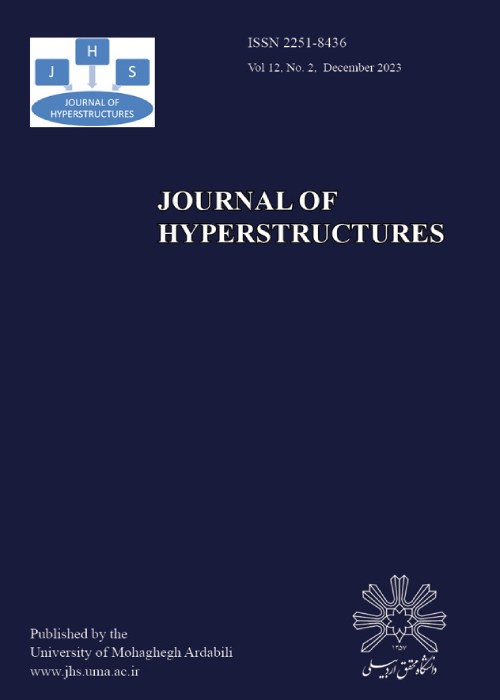فهرست مطالب
Journal of Hyperstructures
Volume:7 Issue: 1, Winter and Spring 2018
- تاریخ انتشار: 1397/08/08
- تعداد عناوین: 7
-
Pages 1-13In this paper we introduce new method for modeling and simulation of genetic algorithm based on meta-models. Eclipse Modeling Framework (EMF) provides a meta-modeling framework to describe models in various abstraction levels. We use this platform and EMF-DEVS to modeling genetic algorithm (GA-DEVS) and generating partial executable codes on DEVS-Suite simulator. Also this process helps modelers to validate models and their structure and I/O validity.Keywords: Modeling, Simulation , Genetic Algorithm, EMF-DEVS, Validation, Meta Modeling.
-
Pages 14-26In this paper, an inverse problem of determining an unknown source term in a time-fractional diffusion equation is investigated. This inverse problem is severely ill-posed. For this reason, a mollification technique is used to obtain a regularized problem. Afterwards, a finite difference marching scheme is introduced to solve this regularized problem. The stability of numerical solution is investigated. Finally, two numerical examples are presented to illustrate the validity and effectiveness of the proposed method.Keywords: Ill-posed problem, Caputo’s fractional derivative, Molli?cation, Marching scheme.
-
Pages 27-35In Bayesian approach, prior knowledge is often vague and any elicited prior distribution is only an approximation to the true one. E-Bayes and robust Bayes approaches consider a class of prior distributions instead of a single prior. In this paper, we deal with Bayes, E-Bayes and robust Bayes estimation of the exponential scale-parameter under a weighted loss function. We conduct a simulation study for comparison of these estimators.
-
Pages 36-49Uncertainty is one of the intrinsic features of natural phenomenon and optimization is not an exception. Parameters in an optimization problem may be inaccurately presented, or due to variation after solving the problem, the current optimal solution may not be optimal or feasible for the new data. One of the approaches towards the uncertainty is the uncertainty theory initiated by Liu in 2007 and completed in 2011. This theory describes the uncertainty originated from human reasoning in mathematical axiomatic words. In this paper, we consider one-stage uncertain linear optimization problem, where the parameters linearly depend on several independent uncertain variables. A solution method is presented which is similar to the branch and bound method for the integer linear program. The presented methodology is explained by simple illustrative examples.Keywords: Uncertainty Theory, One-stage uncertain optimization problem, Linear Optimization.
-
Pages 50-59One of the issues raised in cloud computing is the data center locating problem and one of the effective factors in designing data center locations is amount of data volume and referrals to it. This depends on the number of customers or users who are going to use that data center, which is a probable issue. In this paper, the bandwidth simulation is described by considering the bandwidth system as a queuing system and simulating it by Monte Carlo method. We explain how to simulate the bandwidth consumption in different static and dynamic simulation states for a real computer system and we show that the bandwidth required at an Endpoint in cloud computing can be calculated with different Gamma distribution parameters.Keywords: Cloud Computing, Monte Carlo Simulation, Bandwidth simulation
-
Pages 60-66?The purpose of this paper is to using the Simulated Annealing method to solving a linear equations system which have an ill-conditioned coefficients matrix?. ?A linear equation system is called ill-conditioned if its condition number be large?. ?By using a matrix scaling?, ?the linear equation system transforms into a linear equation system with less condition number?. ?Matrix balancing is performed by Simulated Annealing algorithm?. ?The efficiency of this method is investigated by numerical examples?. ?Numerical results show that Simulated Annealing can reduce the condition number of equations?.Keywords: Condition Number, Matrix Scaling, Simulated Annealing, Linear Equations System.
-
Pages 67-81In this paper, a two-stage stochastic model for optimizing the profit of a smart microgrid is proposed in which the uncertainty of loads, electricity market price and renewable generation are modeled using developing stochastic scenarios with Monte Carlo simulation method. Also, in order to reduce solving time of optimization problem the number of stochastic scenarios is reduced
by Kantorovich distance method.Keywords: Smart microgrid, Two-stage stochastic optimization, Monte Carlo simulation, Kantorovich distance, Uncertainty.


